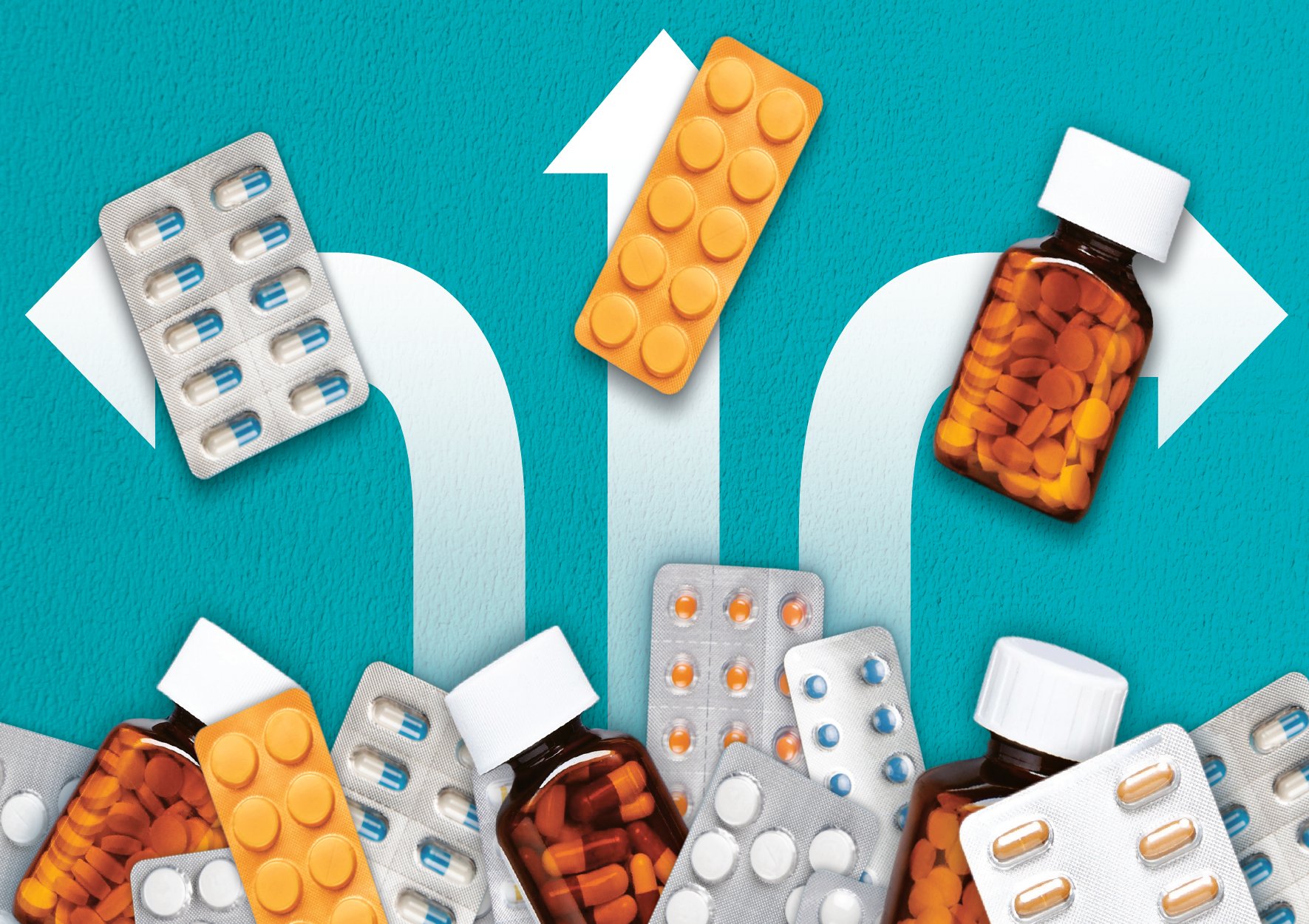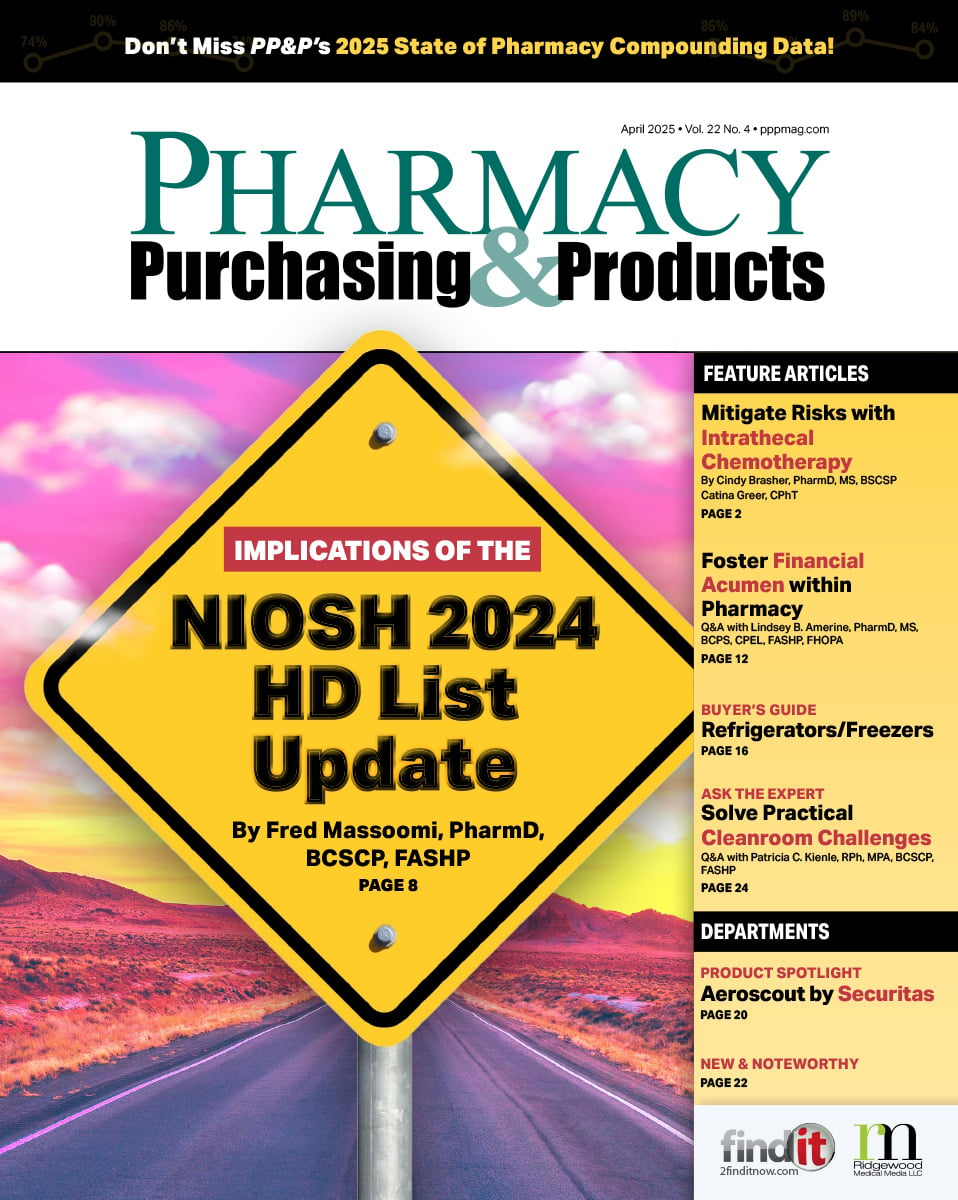- Show Menu
- Contact Us
- FAQs
- Reader Service
- Survey Data
- Survey Winners
- Testimonials
- Upcoming Events
- Webinars
- White Papers
Implementation of Smart Pump Interoperability
Intravenous medication administration practices have changed dramatically over the years, from administration by gravity, to programmable infusion pumps, to smart infusion pumps with dose-error reduction systems (DERS). Today, smart infusion pumps are considered the standard of care in reducing infusion-related medication errors. According to the 2021 State of Pharmacy Automation survey of pharmacy directors, 87% of hospitals use these devices.1 Utilization of this technology has allowed organizations to make a number of notable safety improvements, such as standardizing drug concentrations, establishing consistency in infusion practices, and preventing potentially fatal under- and over-dosing.
Despite these safety improvements, medication errors still occur. However, a bi-directional connection between the electronic health record (EHR) and wireless smart pumps, known as smart pump interoperability, can help to further mitigate these risks. While converting to this technology is a significant undertaking, The University of Pennsylvania Health System has identified ways to streamline this process. With the right preparation and policies, the implementation of smart pump interoperability technology has the potential to minimize manual programming, prevent medication errors, improve workflows, and increase patient and infusion safety.
Background
Smart pump interoperability involves two main features: auto-programming and auto-documentation. Auto-programming is the ability for a patient’s medication order to be electronically transferred from the EHR to the smart pump, while auto-documentation refers to the ability to electronically send infusion related data (eg, start and stop times, volume infused, etc) from the smart pump to the EHR for documentation in the patient’s medication record.
In their 2020 guideline, the Institute for Safe Medication Practices (ISMP) provided specific steps directing organizations on how to implement smart pump interoperability successfully. Organizations that implement smart pump interoperability should engage a multidisciplinary project team, establish organizational expectations for the use of smart pump interoperability with a goal of 95% or greater, and monitor and share data to support ongoing improvements in interoperability performance.2 However, even with these guidelines, this remains a complex and layered project. Key areas for pharmacy to contribute include aligning infusion details between the EHR and smart pump as well as testing of the modifications to the drug library. Using these tactics, The University of Pennsylvania Health System was able to implement bi-directional smart pump interoperability at a large, multi-hospital health system.
The Preparation Phase
Assemble the Right Team
The University of Pennsylvania Health System is headquartered in Philadelphia, Pennsylvania and includes six acute-care hospitals ranging in size from 250 to 800 beds. In addition to the inpatient facilities, the health system includes hundreds of outpatient locations throughout the region, almost 9,000 physicians, and a total of over 44,000 employees. When considering our health system’s large range in facility sizes, various patient care models, and numerous infusion workflows, a diverse interdisciplinary team was necessary to successfully implement smart pump interoperability.
Our team included leaders from pharmacy, nursing, information technology, clinical engineering, nursing education, and medical device integration. In addition to our health system resources, we actively engaged with representatives from our EHR vendor and our smart pump vendor. To coordinate a project of this size and complexity, a project manager was assigned to organize meetings, engage relevant stakeholders, and ensure completion of follow-up tasks.
Practice Standardization
Smart pump interoperability becomes even more challenging if medications are ordered, prepared, or administered differently across the health system. Therefore, it is important to standardize practices as much as possible before implementing interoperability. In the years preceding the implementation of smart pump interoperability, we standardized the concentrations of continuous infusions and their corresponding nursing titration guidelines. In addition, the health system had previously standardized how additive drug volumes and infusion bag overfill would be accounted for in the final total volume of chemotherapy infusions. In advance of the drug library build, pharmacy identified medications where there were practice discrepancies between the hospitals in the health system. Once identified, pharmacy reviewed the medication’s various orders and order sets, compiled a comparison of the dosing and administration workflows from each entity, and developed a proposed standardized approach. The proposal was discussed with both physician and nursing representatives from each entity, and a final health system guideline and order set was developed to ensure consistent practice.
Equally important was identifying and clarifying nursing workflows as early as possible in the interoperability journey. Collaboration with nursing leadership and bedside nurses was necessary in determining how to design the drug library to facilitate safe and appropriate medication administration practices. Key areas to consider included medication priming, bolus medication administration, and flushing of the line after completion of the infusion. A group consensus was reached regarding standard practices for each of these workflows, educational materials were designed, and the necessary drug library builds were incorporated to support interoperability.
Design a Drug Library
The development of a smart pump drug library designed for interoperability is critical to the project. To ensure successful communication between the EHR and the smart pump, the medication order details in the EHR must align with the infusion parameters in the drug library build. This means that all dosing units available in the EHR must have a corresponding drug library entry, including all weight-based, nonweight-based, and BSA-based dosing units. To achieve this, we expanded the drug library builds for a number of our existing medications and worked closely with our information technology representatives to limit the available dosing units wherever possible. Additionally, we expanded the use of custom concentrations in the interoperability-enabled drug library to provide flexibility for drug shortages and urgent changes that occur before scheduled drug library updates.
In our assessment of the existing drug library build, we noted a large number of infusion alerts and overrides. We comprehensively reviewed the existing safety limits, compared them to our health system guidelines and medication orders, and modified limits appropriately to ensure cohesion between the systems. Our goal was to ensure nurses did not receive a DERS alert when programming a medication according to appropriate practice. Additionally, we attempted to predict possible dose rounding issues that could trigger nuisance alerts to fire on the smart pump by expanding our soft and hard limits to account for variation in calculation methods between the EHR and smart pump.
Finally, we made significant modifications to our fluid library to better support interoperability functionality. In clinical practice, fluids are often customizable with wide ranges of safe and appropriate infusion rates (eg, 1–999 mL/hr). We identified early on in the build process that it would be difficult to maintain unique identification numbers to match customizable fluid entries to the appropriate fluid library entry. In response, we created a more “generic” fluid library by condensing it into fewer, more non-specific library entries to support interoperability functionality. This strategy also proved helpful for nurses in situations where they have to utilize manual programming (eg, downtime, emergent situations) as it is easier to find the appropriate fluid entry within the DERS system.
Test for Success
One of the most important components of our pre-implementation phase was the complete and thorough testing of our medication orders. It can be challenging for the patient care team to regain trust in smart pump interoperability if the go-live process is difficult or if there are significant failures. At our institution, we conducted two phases of testing: Phase 1 to ensure technical success and Phase 2 to focus on clinical success.
In Phase 1, we tested every possible combination of medication record and dosing unit available to order in our EHR. This ensured we identified as many potential build issues as early as possible in the project. It took a team of three pharmacists 6 weeks and approximately 240 total hours to fully test every infusion record in both the EHR and drug library. This was a significant time commitment; however, we feel that this investment in testing was a key factor in our eventual success. Through this testing process, we were able to identify and address several technical issues, including medication orders that needed to be reconfigured, DERS limits that were too restrictive, and drug library entries that were missing key technical information (eg, matching dosing unit).
Phase 2 included bedside nurses from across the health system who practice in diverse care areas to ensure clinical success. Nurses tested an estimated 1,300 clinical scenarios to identify and work on clinical concerns. In this testing session, nurses performed their usual clinical workflows to replicate real-world situations. Through this process, we were able to detect workflows that needed to change to support interoperability, practice new interoperability workflows to generate feedback and buy-in from bedside nurses, and work with our nursing education team to develop comprehensive educational materials to share with all staff.
Education and Training
Due to the emergence of the COVID-19 pandemic, the majority of our education and training was delivered virtually. Key training medications and interoperability workflows were identified during our full record testing event. Nursing education created case-based, care-area specific examples and worked with information technology to generate test patients in the training environment. Our nurse educators had developed a live class to teach this information; however, we had to quickly change tactics as in-person meetings were canceled due to the pandemic. Instead, our nurse educators recorded themselves performing the exercises and developed an interactive, guided virtual class that could be taken on-demand. Nurses across the health system were required to complete this online class prior to go-live.
To supplement our on-demand educational materials, nurses had the opportunity to run through interoperability workflows with real, hands-on practice. To achieve this, nursing leadership made test pumps available for each nursing unit that linked with the training environment. Nurses were able to independently visit the test pump to simulate medication administration utilizing interoperability, practice new workflows, and receive feedback from nursing super-users in advance of go-live. Nursing units that engaged with these test pumps were more successful and had fewer issues on the day of go-live.
The Implementation Phase
Go-Live Considerations
At the outset of the project, we chose to implement smart pump interoperability on a site-by-site basis to allow for dedicated support during each facility’s go-live. Unfortunately, we had to alter these plans to accommodate social distancing and on-site vendor restrictions implemented in response to the COVID-19 pandemic. We shifted to a two-phase go-live plan where our largest hospital and outpatient infusion center would go live on the same day, followed by the remaining five hospitals and outpatient infusion centers going live two weeks later. This shift allowed us to ensure the on-site vendor support was available for more of our entities on the day of go-live, especially since our education and training were conducted in a fully virtual format.
Virtual Support Model
For each of the two go-live phases, we provided a minimum of 4 days of command center coverage. The command center was hosted through a virtual meeting platform and the link was made available to super users. Teams of super users and vendor representatives were available on-site for 16 hours each day and virtually for all hours of command center coverage. The enhanced use of virtual communication improved end user access to leadership from the multiple departments involved in this project. This was especially beneficial as we were able to quickly investigate reported issues, perform troubleshooting, and provide both education and feedback directly with the staff members involved. Ultimately, we believe many aspects of the virtual support model increased staff engagement and paved the way for rapid adoption of the process change.
Benefits Realized
Safety
After implementing smart pump interoperability, our health system has noted key improvements in infusion and patient safety. We achieved a high initial rate of compliance with smart pump interoperability, and we have continued to see growth in compliance as familiarity with the workflows has increased. The addition of auto-programming ensures that the correct drug library entry is utilized to program infusions. As a result, we have documented a meaningful increase in the utilization of our drug library and a reduction in the number of programming errors.
We have also noted a significant decrease in the number of infusions with a DERS alert, including overrides, reprogramming, and canceled infusions. Nurses are now able to program infusions more accurately and with fewer disruptions in nursing workflows, enhancing overall patient safety. In addition, preliminary data indicates that when a DERS alert is triggered it is less likely to be overridden by the nurse than it was prior to the implementation of interoperability.
Lastly, the implementation of smart pump interoperability has led to a reduction in the number of infusion related safety events reported through our voluntary event reporting system. We have also been able to review specific infusion information when following up on safety events, provide more focused feedback to staff involved in events, and encourage learning from these events to support our overall culture of safety.
Efficiency and Workflows
The addition of auto-documentation has greatly improved the consistency and accuracy of infusion information in the patient’s chart. Prior to smart pump interoperability, nurses manually estimated infusion volumes and were retroactively documenting rate changes. This resulted in slight variations in documentation tactics between nurses, nursing units, and care areas. Smart pump interoperability has standardized the type and amount of infusion information documented in the patient’s chart, including precise start and stop times, exact time of a rate change, and detailed volume of medication infused. Furthermore, nurses are now able to document multiple infusions at once with just a few clicks, greatly improving the efficiency of the documentation process.
Pharmacy has also benefitted from the enhancement in the accuracy and detail of infusion information obtained from smart pump interoperability. It is now easier to recognize medication replenishment needs, as the timing of rate changes and total volume infused is more visible. Pharmacy has been able to implement additional tools within the EHR, such as automated dispensing, to streamline pharmacy workflows and ensure replacement infusion bags are readily available when they are needed.
Quality Improvement
The pharmacy informatics team developed reports in the EHR to track compliance with auto-programming by unit and by medication. These reports have enabled us to monitor our progress, identify challenging medications or workflows, and target areas for improvements. We are also able to leverage the increased infusion data to identify drug library builds that require modification, such as DERS limit changes or missing medication builds. Finally, we have developed a strategy to test new medication builds to maintain smart pump interoperability functionality and continue our high standards of performance.
Conclusion
Implementation of bi-directional smart pump interoperability is a key recommendation to support the safe use of smart infusion pumps. Smart pump interoperability has improved patient safety and encouraged the standardization of clinical workflows within a large, multi-hospital health system. Pharmacy team members can support the successful implementation of smart pump interoperability in many ways, including by designing the smart pump drug library and participating in testing.
References
- Halvorsen D. Summary. Pharmacy Purchasing and Products. 2020;17(8):4.
- Institute for Safe Medication Practices (ISMP). ISMP Guidelines for Optimizing Safe Implementation and Use of Smart Infusion Pumps. Published February 10, 2020. Accessed May 25, 2021. https://www.ismp.org/node/972.
 Melissa Augustino, PharmD, BCPS, is the medication safety clinical pharmacy specialist at the Hospital of the University of Pennsylvania in Philadelphia, Pennsylvania. She received her doctor of pharmacy degree from the University of Maryland School of Pharmacy and completed her PGY-1 pharmacy practice residency at Howard County General Hospital. Dr. Augustino also completed a PGY-2 in medication-use safety at the Johns Hopkins Hospital in Baltimore, Maryland.
Melissa Augustino, PharmD, BCPS, is the medication safety clinical pharmacy specialist at the Hospital of the University of Pennsylvania in Philadelphia, Pennsylvania. She received her doctor of pharmacy degree from the University of Maryland School of Pharmacy and completed her PGY-1 pharmacy practice residency at Howard County General Hospital. Dr. Augustino also completed a PGY-2 in medication-use safety at the Johns Hopkins Hospital in Baltimore, Maryland.
Dr. Augustino’s primary role is to investigate medication-related events and develop system changes that promote the safe use of medications within the hospital and health system. She is a member of various committees supporting patient and medication quality and safety, and leads and participates in numerous multidisciplinary initiatives to improve safety, efficiency, therapeutic appropriateness, and compliance with regulatory standards.
Like what you've read? Please log in or create a free account to enjoy more of what www.pppmag.com has to offer.








